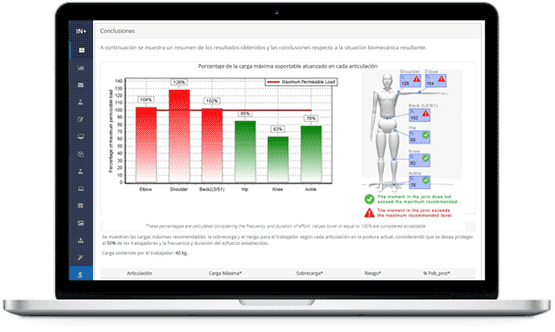

The Snook and Ciriello Tables, also known as Liberty Mutual Tables, aim to offer guidelines for assessing and designing manual load handling tasks while taking into account workers' limitations and capabilities. This helps reduce the occurrence of low back injuries (Snook 1987). These tables establish the Maximum Acceptable Weight, representing the heaviest weight a person can manage at a specific frequency and duration without experiencing stress or fatigue. This concept applies to both the load's weight during lifting, lowering, or holding actions and the force exerted during pushing or pulling actions. The tables determine maximum acceptable weights for five population percentiles: 10, 25, 50, 75, and 90. This means the maximum acceptable weights are safe for 10, 25, 50, 75, and 90% of the male or female population.
In "The design of manual handling tasks", an article published in the journal Ergonomics, S.H. Snook and V.M. Ciriello presented their research on manual load handling conducted at Liberty Mutual Company. This study featured tables listing maximum acceptable weights for various manual load handling actions, such as lifting, lowering, pushing, pulling, and carrying loads, with distinctions made by gender. After conducting additional experiments, the authors revised these tables and published them under the title The design of manual handling tasks: revised tables of maximum acceptable weights and forces.
To create the tables, the researchers evaluated the abilities of male and female industrial workers. They collected psychophysical measurements, including oxygen consumption, heart rate, and anthropometric characteristics. Independent variables considered in the study were frequency, distance, height, and duration of manipulation; object size and grips; horizontal reaches; and task combinations. The researchers combined the results of these experiments with those from similar studies published earlier (Ciriello and Snook 1978). Further research by Liberty Mutual Insurance (Liberty Mutual Research Center) on manual load handling using a psychophysical approach can be found in the references listed in the bibliography.
Remember...
TheSnook and Ciriello Tables allow the evaluation and design of tasks involving manual handling of loads. They take into account the limitations and capabilities of workers and contribute to the reduction of low back injuries.
Remember...
The maximum acceptable weight refers both to the weight of the load, when the manipulation is a lifting, lowering or holding, and to the force exerted when the manipulation is a pushing or pulling.
The Snook and Ciriello Tables present Maximum Acceptable Weights for various types of load handling. Keep in mind that the maximum acceptable weight applies to both the load's weight during lifting, lowering, or holding actions and the force exerted during pushing or pulling actions. There are nine tables in total: lifting for men, lifting for women, unloading for men, unloading for women, dragging for men, dragging for women, pushing for men, pushing for women, and transport for both men and women (the same table provides values for both genders). Some versions of the tables may combine or further break down these categories.
Using these tables is straightforward. Simply consult the table that corresponds to the manual load handling action you wish to evaluate. However, applying the method can be challenging because the table entries do not cover all possible action scenarios. Consequently, the evaluator must choose the entries that most closely match their specific situation. When comparing different approximation options, it is recommended to select the most restrictive in weight, meaning the one with the lowest maximum acceptable weight. In this case, a linear interpolation can be performed between the nearest lower and higher tabulated values.
For instance, let's say we want to find the Maximum Acceptable Weight for a situation with a vertical distance of d but the corresponding table only provides values for d1 (lower than d) and d2 (greater than d). Assuming the Maximum Acceptable Weight for d1 is P1 and for d2 is P2, we can calculate the Maximum Acceptable Weight for d as follows:
P = P1 + (P2 - P1) [(d - d1)/(d2 - d1)]
After determining the Maximum Acceptable Weight for the situation under analysis, you must adjust its value if special circumstances occurs, such as when the load lacks handles or offers an inadequate grip, or when the load is handled away from the body.
- If the load does not have handles or does not allow an acceptable grip, the Maximum Acceptable Weight should be reduced by 15%.
- If the load is handled away from the body the Maximum AccepTable Weight shall be reduced by 50%.
Remember...
The Table corresponding to the manual handling action to be evaluated should be consulted.
The tables do not cover all possible situations of an action. In this case it is advisable to perform a linear interpolation between the values tabulated immediately below and above.
If no interpolation is performed, the option with the lowest Maximum Acceptable Weight will be chosen.
Remember...
Once the Maximum AccepTable Weight has been obtained for the situation under study, its value must be corrected in the following cases:
If the load does not have handles or does not allow an acceptable grip, the Maximum Acceptable Weight should be reduced by 15%.
If the load is handled away from the body the Maximum AccepTable Weight shall be reduced by 50%.
The following issues should be considered when using the Snook and Ciriello Tables:
Some maximum acceptable weights in the tables are not based on experimental data but derived from extrapolations. For instance, in both the men's and women's unloading tables, maximum acceptable weights for loads with widths of 49 cm and 75 cm are not experimentally determined but come from adjustments of data from other lifting tasks.
A few of the tabulated maximum acceptable weights surpass the recommended physiological criteria (NIOSH 1981) for continuous performance over eight hours or more. In such cases, a recommended limit of 1000 ml/min of oxygen consumption for men and 700 ml/min for women is established. In the revised tables (Snook & Ciriello 1991), values exceeding these limits appear in italics.
The table values correspond to simple manual load handling tasks, meaning there is no procedure for evaluating multiple tasks simultaneously. The method's authors suggest analyzing each component of a multi-task individually, using the combined task's frequency as the frequency value. After completing this analysis, the lowest of the maximum recommended weights will be considered as the maximum acceptable weight for the composite task. However, this approach raises concerns because the physiological cost of composite tasks is higher than that of individual components, and the composite task might exceed the recommended physiological limits.
Ciriello, V.M., Snook, S.H., 1978. The effects of size, distance, height, and frequency on manual handling performance. In: Human Factors and Ergonomics Society (Ed.), Proceedings of the Human Factors Society 22nd Annual Meeting, Santa Monica, CA., pp. 318–322.
Ciriello, V.M. & Snook, S.H., 1983. A study of size distance height, and frequency effects on manual handling tasks. Human Factors 25 5, pp. 473-483.
Snook, S.H., 1971.The effects of age and physique on continuous work capacity, Human Factors, 13, 467-479.
Snook, S.H., 1978.The design of manual handling tasks, Ergonomics, 21, pp. 963-985.
Snook, S.H., 1978. Maximum weights and workloads accepTable to female workers, Journal of Occupational Medicine, 16, pp. 527-534.
Snook, S.H., 1987. The design of manual handling tasks: revised Tables of maximum accepTable weights and forces, Ergonomics, 34, pp. 1197 - 1213.
Snook, S.H. & Ciriello, V.M., 1974. The effects of age and physique on continuous work capacity, Human Factors, 13, 467-479.
Snook, S.H. & Ciriello, V.M., 1991. The design of manual handling tasks: revised Tables of maximum accepTable weights and forces, Ergonomics, 34, 9.
Snook, S.H. & Irvine, C.H., 1967. Maximum accepTable weight of lift, American Industrial Hygiene Association Journal, 28, pp. 322-329.
Snook, S.H., Irvine, C.H. & Bass, S.F., 1970. Maximum weights and work loads accepTable to male industrial workers, American Industrial Hygiene Association Journal, 31, pp. 579-586.
Assessment of manual handling of loads using the Snook and Ciriello Tables. Ergonautas, Universidad Politécnica de Valencia, 2023. Available online: https://www.ergonautas.upv.es/ergoniza/app_en/land/index.html?method=snook_y_ciriello
A cloud based software that integrates more than 20 tools for managing the ergonomics of the workstations in your company.
Evaluate all ergonomic risk factors of the workstations in your company: inadequate postures, repetitive movements, load handling, thermal environment...

Use Artificial Intelligence for the automated detection of postures in photographs or videos.
Generate fully customizable reports in Microsoft Word or Adobe Pdf format.
In a multiuser environment so that your company can have access to your data everywhere.
You only need a free account on Ergoniza
ERGONIZA allows you to use Artificial Intelligence for postural load assessment. Automatically capture workers’ postures from a photograph or a video and obtain an automated evaluation of the risk associated with inadequate or forced postures.
AI in actionERGONIZA helps you manage the ergonomics of the workstations of your companies. Evaluate all the risk factors present in the workstations, manage the evaluations, and obtain editable and customizable reports.
You only need to register as a user of ERGONIZA to start testing.
Sign UpUnlock the full potential of Ergoniza. By becoming a Pro User you'll have access to all of Ergoniza and be able to use all of the online software without restrictions or time limits. You'll be able to use the results of evaluation methods and tools in your professional activity. You'll be able to print the results reports in pdf or Word and save your studies in files to open them later.
To register as a Pro user, you must first login to Ergoniza.
(*) In European Union countries, the price will be increased with the corresponding VAT.
(**) The price in american dollars has been calculated at the current exchange rate and may vary.
is a web by . Ergonautas is the specialized website in occupational ergonomics and ergonomic assessment of workstations at the . Ergonautas aims to be a useful support tool for the Occupational Risk Prevention and Ergonomics professional and people in training, providing rigorous technical information on occupational ergonomics, online tools for its application, research, training, and participation forums.
Ergonautas is formed by a large human team. In addition to technicians and programmers, the Ergonautas team is made up of researchers and professors from the Polytechnic University of Valencia. The team, led by José Antonio Diego Más, is at the forefront of research and teaching in ergonomics, teaching in official degrees and master's degrees, and developing research projects in the field of ergonomics and new technologies oriented towards humans.
If you need to know more, get in touch with Ergonautas
Or follow us on Linkedin
- - -
© 2006 - Universidad Politécnica de Valencia




